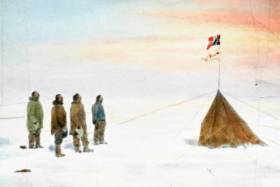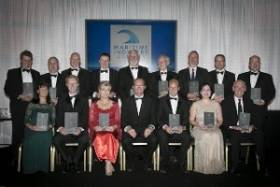Displaying items by tag: SeaFest 2017
Galway Hosts Amundsen Exhibition Ahead Of SeaFest
#Amundsen - A unique exhibition on Roald Amundsen’s expedition to the South Pole was officially opened at NUI Galway by Seán Kyne TD, Minister of State for Gaeltacht Affairs and Natural Resources, on World Oceans Day (Thursday 8 June).
A collaboration between NUI Galway and the Marine Institute, in association with the Norwegian Embassy and the Fram Museum in Oslo, Cold Recall – Roald Amundsen’s Reflections from the South Pole will be on display in the O’Donoghue Centre for Drama, Theatre and Performance at NUI Galway till Saturday 8 July.
Amundsen was the first in the world to navigate the Northwest Passage and the first to reach the South Pole on 14 December 1911.
Norwegian Polar history is closely connected to defining Norway as an independent state in 1905, and to Norway's position as a state closely connected to the oceans and to polar regions.
Her Excellency Else Berit Eikeland, Ambassador of the Royal Norwegian Embassy to Ireland, expressed her delight that the exhibition will be on display in Galway.
“Amundsen’s party had immense courage and determination to make the dangerous trek across the ice and snow to reach the South Pole,” she said. “This exhibition offers a pictorial account of the expedition and of Amundsen, one of the greatest figures in the field of polar exploration and a national hero for a very young nation.”
Speaking ahead of the opening last Thursday, NUI Galway president Dr Jim Browne, said: “Polar exploration remains a rich source for academic researchers and here in NUI Galway our academics are engaged with polar research in a range of ways and in such diverse field as particle physics, climate change, marine biology and biodiscovery, and even the literary history of polar travel.”
Marine Institute chief executive Dr Peter Heffernan added: “The exploration and voyages across our oceans and particularly Amundsen's extraordinary journey to the South Pole are important to our maritime history. Through this exhibition, visitors can remember and celebrate one of the most remarkable feats of exploration.”
The exhibition runs in association with SeaFest 2017, Ireland’s national maritime festival, taking place in Galway from 30 June to 2 July .
Last month Marine Minister Michael Creed officially opened Ireland’s first sea science gallery at Galway City Museum to mark the launch of the festival, as previously reported on Afloat.ie.
#OurOceanWealth - Tom Kelley of award-winning global design and development firm IDEO will encourage leaders in Ireland's marine sector to engage in creative thinking at the 2017 Our Ocean Wealth Summit in Galway this June.
Kelley is regarded as a leader in innovation management and design, with proven techniques for fostering a culture of creativity and developing processes for continuous innovation.
He is the author of The Art of Innovation and The Ten Faces of Innovation, as well as Creative Confidence – a best-selling guide to recognising and unleashing the creative potential in employees.
Marine Institute chief executive Dr Peter Heffernan said Kelley will stimulate innovative thinking at this year's Our Ocean Wealth Summit.
"Using the concepts of design thinking, Kelley will encourage delegates to adopt creative, problem-solving methods. He will challenge current perspectives and encourage new ideas and approaches on how Ireland can continue to transform the marine industry.
"Policy makers, researchers and industry leaders will be exposed to new techniques, which will help us work together to achieve sustainable economic prosperity and ensure our marine resources are protected for future generations."
The fourth annual Our Ocean Wealth Summit will consider the changing and diversified marine industries, and how achieving sustainable economic growth and protecting the ocean's health is both a challenge and an imperative.
"It is also valuable for our audience to her the views of an expert from another industry," added Dr Heffernan. "Kelley will offer his own unique insights on some of the challenges faced by the marine sector and how he believes progress can be achieved."
Kelley will present to national and international delegates at Our Ocean Wealth Summit on Friday 30 June at NUI Galway, where delegates will also receive a progress update on Ireland's Integrated Marine Plan - Harnessing Our Ocean Wealth.
Our Ocean Wealth Summit will be held as part of SeaFest 2017, Ireland's national maritime festival. To register for the Our Ocean Wealth Summit visit www.ouroceanwealth.ie/register
Entries Open for Marine Industry Awards
#MarineAwards - The Marine Industry Awards are Ireland's premier event to showcase on a national scale excellence and innovation within our marine sector.
Now in the third year, the Awards are a significant event which will be held during SeaFest in Galway. The Awards ceremony takes place on Thursday, June 29th at the Radisson Blu Galway.
The Awards offers a unique opportunity to celebrate industry excellence and network with its most distinguished figures and leading organisations.
Of the 15 categories open for entries, the Marine Industry Awards offer companies an excellent opportunity to showcase the diversity of the marine sector, and the role of companies operating within it. Winners will be selected by an esteemed panel of judges comprising of well-respected professionals and experts across all areas of the marine industry.
So to considering entering your company, entries are now open until April 12th, to apply click online here.
Below are the list of the 15 Marine Industry categories.
Overall Marine Excellence Award
Marine Industry Leader 2017
Future Achiever Award
Ports & Harbours Operator of the Year – Large
Ports & Harbours Operator of the Year – Small
Ship Operator of the Year
Offshore Ireland Award
Marine Tourism & Leisure Operator of the Year
Marine Industry Supplier of the Year
Seafood Business Innovation Award
Seafood Sustainability Award
Excellence in Marine Renewable Energy Award
Excellence in Marine Safety Award
Excellence in Marine Technology Award
Excellence in Marine Education & Training Award
Excellence in Marine Research Award
Excellence in the Provision of Professional Services to the Marine Industry
In addition to assist in making an application for a category, click this PDF Entry Guide booklet here.































































